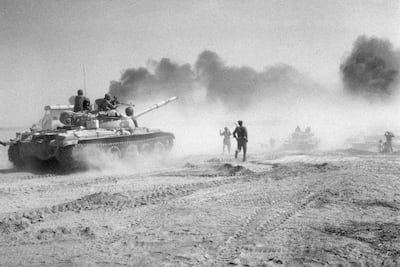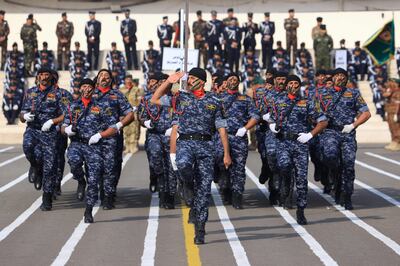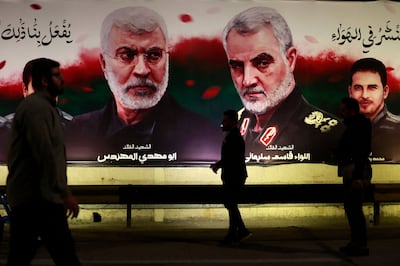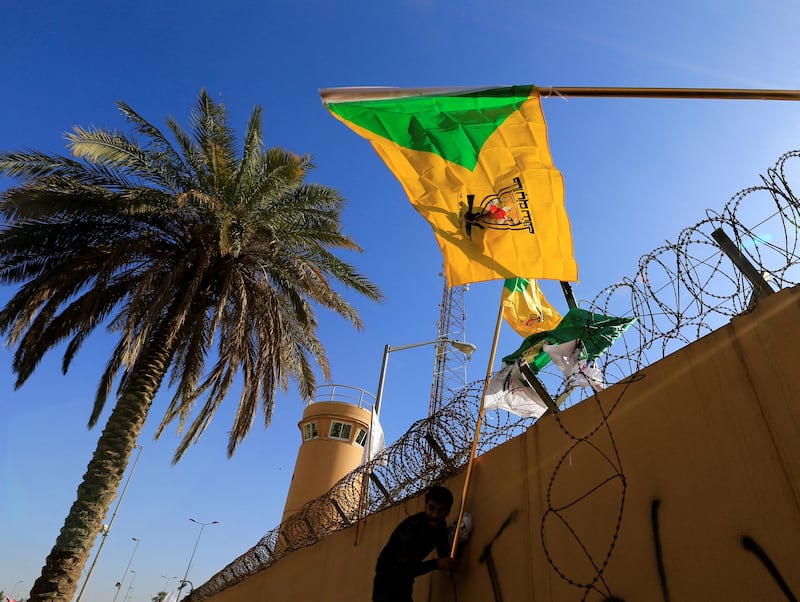The US is primed to strike Iran-backed militia Kataib Hezbollah and its allies in Iraq after Sunday’s deadly drone strike in Jordan, which killed three American soldiers and was described by US officials as characteristic of the group's activity.
Kataib Hezbollah wants the US to stand down, and on Tuesday declared a halt to its attacks against US targets, although some analysts say it will probably form a new group to continue attacks.
Kataib Hezbollah also leads a Shiite militia alliance called the Islamic Resistance in Iraq, which initially was seen as a front organisation. However, Kataib Hezbollah admitted its connection to the organisation in November.
Other groups in the “resistance” outfit include Harakat Al Nujaba, and Kataib Sayyid Al Shuhada, who have a long history of attacking US forces and fighting in Syria. All have well-documented ties to Iran, publicly supporting Tehran's theocracy or thanking Iran for material support.
But who exactly are the militants who have once again found themselves in America’s crosshairs?
From their early origins after the 2003 US-led invasion of Iraq invasion to becoming Washington’s nemesis in Iraq and Syria, Kataib Hezbollah has a controversial history, with its members allegedly involved in abducting and killing civilians during Iraq’s post-invasion sectarian strife and the war on ISIS, and later the killing of hundreds of Shiite protesters in 2019-2020.
The group rose from a small coalition of Iran-backed radicals in the chaos of the US occupation, eventually becoming a fully funded group linked to the Iraqi government, with millions of dollars in income, advanced drones and ballistic missiles.
Where did Kataib Hezbollah come from?
Iraq’s Shiite militias attacking US and coalition forces since 2003 fall broadly into three categories: those formed to fight Saddam Hussein’s regime in the 1980s and 1990s, those formed after 2003 specifically to strike US troops, and those formed during the 2014-2018 war against ISIS.
Kataib Hezbollah are in the second category, but its founders, including Abu Mahdi Al Muhandis, were members of either Iraq’s Dawa party – a conservative Shiite party founded in the 1950s whose members faced the death penalty if caught during Saddam's regime – or the Islamic Supreme Council of Iraq. The latter was formed in Iran by its Islamic Revolutionary Guard Corps.
Al Muhandis was a member of all three groups at different points.

Members of these opposition groups were exiled to Iran or Syria, but took divergent paths, with Dawa members being accused of acts of terrorism, striking back at Saddam’s regime crackdowns in Iraq and the wider region.
The ISCI, meanwhile, developed an armed unit called the Badr Brigades, which acted as an insurgent force during the long and bloody Iran-Iraq war, which Al Muhandis fought in.
It is from the Badr Brigades, later the political party Badr Organisation, that Kataib Hezbollah emerged.
According to one close observer of Iraqi militias, “Kataib Hezbollah came from Badr because Badr was unwilling to fight the coalition and joined the National Police.”

In other words, Badr saw an opportunity to support the post-2003 Shiite-dominated Iraqi government and, alongside Dawa, worked with the US.
Badr infiltrated security forces, pursuing a sectarian agenda, but loosely co-operating with the coalition, while Kataib Hezbollah broke away to fight US forces.
Despite its origins in Iraq's anti-occupation insurgency, which included highly conservative followers of Shiite cleric Moqtada Al Sadr, Kataib Hezbollah did not announce its existence until 2007.
At the time, Al Muhandis was an MP in Iraq, having been elected in 2005, but reportedly spent most of his time in Iran after being accused by the US and Kuwait of masterminding the bombing of the French and US embassies in Kuwait in 1983.
What are Kataib Hezbollah's ties to Iran?
Al Muhandis later worked with Iranian general Qassem Suleimani, who would go on to lead the IRGC's overseas operations arm, the Quds Force. They organised hundreds of attacks against US forces, bringing Iranian weapons into Iraq and killing 603 American troops between 2003 and 2011, according to the Pentagon.
The Quds Force became the vanguard of Tehran's efforts to build allied Shiite militias across the region. Al Muhandis died in the same vehicle as Suleimani in a US drone strike in 2020 near Baghdad airport, after a series of militia clashes with the US.
By the time of his death, Al Muhandis had become instrumental in turning Iraq's Popular Mobilisation Forces from a disparate group of militias into an official Iraqi government-funded body that leant heavily towards Iran, even clashing with Iraqi police and commandos.

Accusations that Iran has closely advised, trained and armed Kataib Hezbollah and allied groups have persisted.
US intelligence cables, leaked in 2011, describe Al Muhandis as one of Iran’s key allies and say his militia was probably trained in Iran before returning to Iraq to attack American troops. Similar allegations persist today in US Treasury documents on sanctions.
Since Al Muhandis’s death, Kataib Hezbollah commander Abu Al Mohammedawi has risen to become the chief of staff of the PMF, alongside Kataib Hezbollah's overall commander Ahmad Al Hamidawi, who led units of the militia in support of Syrian President Bashar Al Assad during the country's civil war.
The PMF's funding has been doubled in the most recent Iraqi budget, which, along with its holdings in property, farmland and businesses, has left Kataib Hezbollah more powerful than ever.







